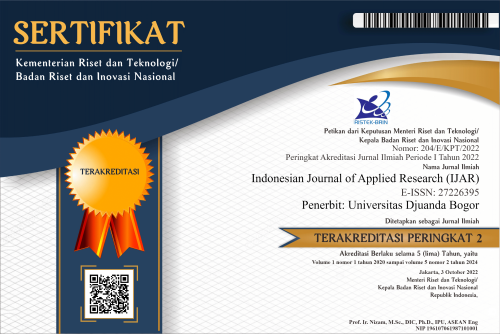The Implementation of Occupational Health and Safety for Pregnant Workers in Various Workplaces
Abstract
Pregnant workers have more health risks for health problems than other workers. There are different potential hazards in different workplaces. Occupational Health and Safety Programs need to be implemented for pregnant workers in order to avoid work related diseases in various workplaces. This study aims to determine the the implementation of occupational health and safety for pregnant workers in various workplaces. This study uses a qualitative method by conducting FGD (Focus Group Discussion) with pregnant women workers from various workplaces and in-depth interviews with occupational health and safety experts. Occupational health and safety programs have been implemented for pregnant workers such as the right to maternity leave, working hours arrangements, health insurance, and special protection for pregnant workers. However, there are some workplaces that still do not provide special protection for pregnant workers. Every workplace should pay more attention to the health and safety of pregnant workers as an effort to prevent occupational accidents and work related diseases
References
Dagher, Rada & Mcgovern, Patricia & Dowd, Bryan. 2013. Maternity Leave Duration and Postpartum Mental and Physical Health: Implications for Leave Policies. Journal of health politics, policy and law.
Darwin, Muhadjir & Wijaya. 1994. Kesehatan Reproduksi Pekerja Wanita. Populasi 5 (2).
Hakim, lukmanul. 2011. Perkembangan tenaga kerja wanita di sektor informal: Hasil analisa dan proxy data sensus penduduk. Among makarti, vol.4 no.7, juli 2011.
International Labour Organisation. 2009. Konvensi tentang Kerja Malam bagi Wanita yang dipekerjakan di Industri (Hasil Revisi tahun 1948). www.ilo.org.
International Labour Organisation. 2000. Konvensi Perlindungan Maternitas. www.ilo.org.
Law of Republic Indonesia Number 1 of 1970 concerning Work Safety
Law of Republic Indonesia Number 13 Year 2003 concerning Labour
Law of Republic Indonesia Number 36 of 2009 concerning Health
Mangkunegara, Prabu. 2013. Manajemen Sumber Daya Manusia Perusahaan. Bandung: PT Remaja Rosdakarya.
Martiana, et al. 2018. Dual roles of Mothers Working in the Indonesia Industry: Its Effects on Maternal and Child Health in Sidoarjo. Indian Journal of Public Health Research and Development.
Priyadarshini, Vijayeta. 2016. A comparative study on dietary patterns and nutritionalstatus among working and non-working women of Keonjhar city. Asian Journal of Home Science. Volume 11. Issue 2. 320-326.
Rijuna, Dewi. 2006. Pengaruh Keselamatan dan Kesehatan Kerja terhadap Kinerja Karyawan pada PT. Ecogreen Oleochemicals Medan Plant. Skripsi Fakultas Ekonomi Universitas Sumatera Utara Medan.
Satori, D. Komariah. 2010. Metodologi Penelitian Kualitatif. Bandung : Alfabeta.
Sugiyono, 2010. Metode Penelitian Kuantitatif Kualitatif dan R & D. Bandung : Alfabeta.
Sunyoto, D. 2012. Manajemen Sumber Daya Manusia. Jakarta: PT Buku Seru.
Swedish Work Environment Authority. 2017. The Swedish Work Environment Authority's Statute Book. Swedia.
The Hesperian Foundation. 2010. Bahaya Bahan Kimia Beracun. https://hesperian.org/wp-content/uploads/pdf/id_cgeh_2010/id_cgeh_2010_16.pdf.
Copyright (c) 2021 Indonesian Journal of Applied Research (IJAR)

This work is licensed under a Creative Commons Attribution-ShareAlike 4.0 International License.
The Authors submitting a manuscript do so on the understanding that if accepted for publication, copyright publishing of the article shall be assigned/transferred to Indonesian Journal of Applied Research (IJAR) Universitas Djuanda as Publisher of the journal. Upon acceptance of an article, authors will be asked to complete a 'Copyright Transfer Agreement'. An e-mail will be sent to the corresponding author confirming receipt of the manuscript together with a 'Copyright Transfer Agreement' form by online version of this agreement.
Indonesian Journal of Applied Research (IJAR) Universitas Djuanda, the Editors and the Editorial Board make every effort to ensure that no wrong or misleading data, opinions or statements be published in the journal. In any way, the contents of the articles and advertisements published in the Indonesian Journal of Applied Research (IJAR) Universitas Djuanda are sole and exclusive responsibility of their respective authors and advertisers.
Remember, even though we ask for a transfer of copyright, our journal authors retain (or are granted back) significant scholarly rights as mention before.
The Copyright Transfer Agreement (CTA) Form can be downloaded here: Copyright Transfer Agreement-IJAR 2020
The copyright form should be signed electronically and send to the Editorial Office e-mail below:
Prof. Dr. Ir. Dede Kardaya, M.Si. (Editor-in-Chief)
Universitas Djuanda
Jl. Tol Jagorawi No.1, Ciawi, Kec. Ciawi, Bogor, Jawa Barat 16720
Website: http://journal.unida.ac.id/index.php/IJAR/index
Email: ijar@unida.ac.id






 This work is licensed under a
This work is licensed under a 